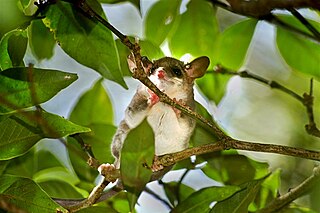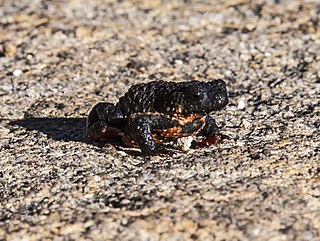
The harpy eagle is a neotropical species of eagle. It is also called the American harpy eagle or Brazilian harpy eagle to distinguish it from the Papuan eagle, which is sometimes known as the New Guinea harpy eagle or Papuan harpy eagle. It is the largest and most powerful raptor found throughout its range, and among the largest extant species of eagles in the world. It usually inhabits tropical lowland rainforests in the upper (emergent) canopy layer. Destruction of its natural habitat has caused it to vanish from many parts of its former range, and it is nearly extirpated from much of Central America. In Brazil, the harpy eagle is also known as royal-hawk. The genus Harpia, together with Harpyopsis and Morphnus form the subfamily Harpiinae.

Melanophryniscus is a genus of toads in the family Bufonidae. They are found in northern half of Argentina, southern Bolivia, southern Brazil, Paraguay, and Uruguay. Common name South American redbelly toads has been coined for them.

A true toad is any member of the family Bufonidae, in the order Anura. This is the only family of anurans in which all members are known as toads, although some may be called frogs. The bufonids now comprise more than 35 genera, Bufo being the best known.

Marmosops is a genus of Neotropical opossums of the family Didelphidae. The genus was originally treated as a subgenus from the genus Marmosa rather than having their own classification. This was changed in 1989 by Gardner and Crieghton, who officially separated the group and made them their own genus. The mix-up between to genera Marmosa and Marmosops was common due to the similar appearances including size and other external features. However, the two groups differ significantly in their integument and in the arrangement of their skull and dentition. The dentition is similar in morphology between the two groups, with the exception of the deciduous lower third premolar varying from one genus to the next. The similarity between the two continues to cause the genus Marmosops to be frequently misidentified due to the lack of knowledge regarding the species along with the overlooked traits that help separate them from other opossums. The Marmosops are also commonly confused with the genus Gracilinanus, but this is quickly ruled out by a large number of differing characteristics. These differences include the arrangement of their digits, caudal scales, and the central hair on the scales changing from a three hairs per follicle to many more. This causes the hair of the Gracilinanus to be thicker and has also found to be heavily pigmented. The last group commonly confused with Marmosops is known as the genus Thylamys. These animals have a contrasting dorsal body pelage and the taxa are actually quite different.

Melanophryniscus atroluteus is a species of toad in the family Bufonidae. It is found in northeastern Argentina, Uruguay, southern Paraguay, and southern Brazil. While in the past it was considered a subspecies of Melanophryniscus stelzneri, it might rather be conspecific with Melanophryniscus montevidensis. Common name Uruguay redbelly toad has been coined for it.

Melanophryniscus cambaraensis is a species of toad in the family Bufonidae. It is endemic to Brazil. Its natural habitats are subtropical or tropical moist lowland forests, moist savanna, subtropical or tropical seasonally wet or flooded lowland grassland, rivers, intermittent freshwater marshes, and canals and ditches. It is threatened by habitat loss.

Melanophryniscus devincenzii is a species of toad in the family Bufonidae. It is found in Argentina, Uruguay, possibly Brazil, and possibly Paraguay. Its natural habitats are subtropical or tropical moist lowland forests, subtropical or tropical seasonally wet or flooded lowland grassland, intermittent rivers, rocky areas, and plantations. It is threatened by habitat loss.
Melanophryniscus fulvoguttatus is a species of toad in the family Bufonidae. It is found in Argentina, Brazil, and Paraguay. Its natural habitats are subtropical or tropical moist shrubland, subtropical or tropical seasonally wet or flooded lowland grassland, and intermittent freshwater marshes. It is threatened by habitat loss.
Melanophryniscus klappenbachi is a species of toad in the family Bufonidae. It is found in the Gran Chaco in northern Argentina, Paraguay, and Brazil, and possibly in Bolivia. Its specific name refers to Miguel Angel Klappenbach, a Uruguayan zoologist.
Melanophryniscus macrogranulosus is a species of toad in the family Bufonidae. It is endemic to northeastern Rio Grande do Sul, southern Brazil. It was for a long time only known from the type series collected in 1960, until another population was discovered in 2004. This was followed by the rediscovery of population at the type locality as well as few other populations, all in Rio Grande do Sul. Its common name is Torres redbelly toad, after the type locality.

The Maldonada redbelly toad is a species of toad in the family Bufonidae. It is endemic to Brazil. Its natural habitats are subtropical or tropical high-altitude grassland, swamps, and intermittent freshwater marshes.
Melanophryniscus pachyrhynus is a species of toad in the family Bufonidae. It is known from São Lourenço do Sul in southern Brazil and from Uruguay. Populations in Uruguay were until recently considered a different species and assessed as being vulnerable.
Melanophryniscus sanmartini is a species of toad in the family Bufonidae. It is found in Uruguay and southernmost Brazil. Its natural habitats are grasslands and rocky outcrops. Reproduction takes place in small streams. It is threatened by habitat loss caused by exotic tree plantations.

Melanophryniscus simplex is a species of toads in the family Bufonidae.
Melanophryniscus spectabilis is a species of toads in the family Bufonidae.
Melanophryniscus tumifrons is a species of toad in the family Bufonidae. It is endemic to Brazil. Its natural habitats are subtropical or tropical moist lowland forests, moist savanna, subtropical or tropical seasonally wet or flooded lowland grassland, intermittent freshwater marshes, pastureland, and heavily degraded former forest. It is threatened by habitat loss.
Melanophryniscus admirabilis is a species of toads in the family Bufonidae. It is endemic to Brazil.

Melanophryniscus dorsalis is a species of toad in the family Bufonidae which is endemic to the coastal Brazil. It is threatened by habitat loss. Its natural habitats are subtropical or tropical sand dunes and nearby areas. It breeds in temporary pools.

Melanophryniscus xanthostomus is a species of toads in the family Bufonidae, first found in the Atlantic Forest in Santa Catarina, Brazil. It is found at intermediate-high altitudes and has a phytotelm-breeding reproductive strategy. It is distinguished from its cogenerate species based on differences in snout-vent length; having white and/or yellow spots on its forearms, mouth, belly and cloaca; the pattern and arrangement of warts; and the presence and number of corneous spines. It might be threatened by habitat loss.
Melanophryniscus biancae is a species of toads in the family Bufonidae, first found in the Atlantic Forest in Santa Catarina, Brazil. It is found at intermediate-high altitudes and has a phytotelm-breeding reproductive strategy. It is distinguished from its cogenerate species based on differences in snout-vent length; having white and/or yellow spots on its forearms, mouth, belly and cloaca; the pattern and arrangement of warts; and the presence and number of corneous spines. It might be threatened by habitat loss. It was named in honor of Bianca Reinert due to her conservation efforts.









